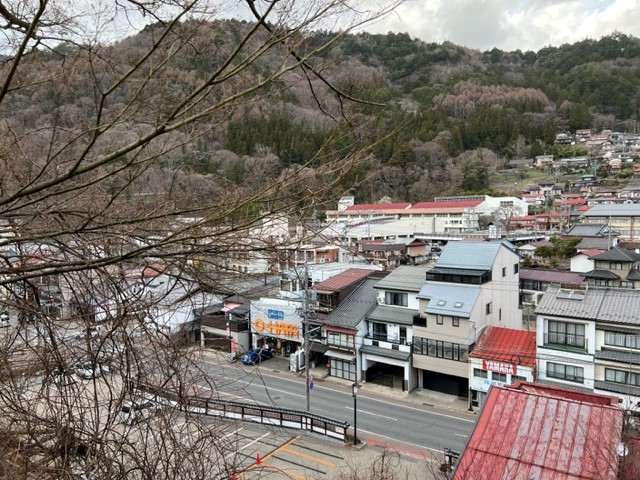
The lovely Nagi (Nikki to her Western friends) greets us on arrival at the ryokan – the traditional Japanese inn – in Kiso Fukoshima. Nagi takes us straight out again on a tour of the village. Up to the old Samurai checkpoint where travellers were searched for weapons (you couldn’t be too careful who you met on the road in those days). Then on to the street of traditional Japanese houses, the local sake factory, and across the river to the artisan miso soup shop. And finally, to the village footbath – a channel of water from the hot springs where feet can be publicly bathed, followed by a walk across the reflexology paving stones, all built into the footpath. The same water feeds the ryokan’s onsen – the male and female hot baths that are one of the unique experiences of staying at a ryokan.
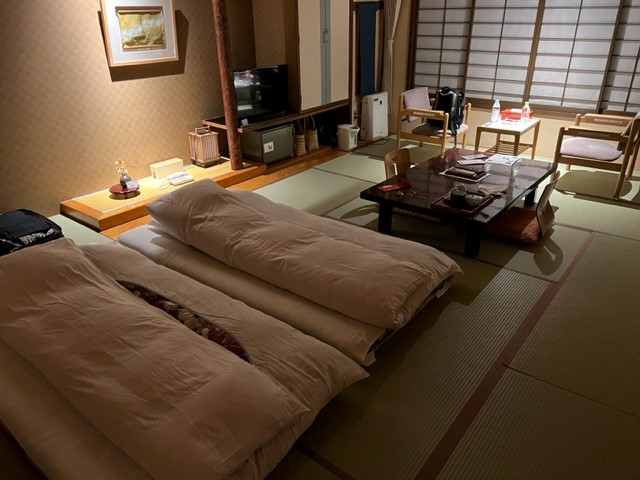
Our room at the ryokan is Japanese Minimalist. We leave our shoes at the entrance and walk or kneel on the tatami mats. Tatamis are a standard size, twice as long as wide and are laid out in a brick-wall structure. Room sizes can be measured by the mats (as in the ‘Hall of one thousand tatamis’) – ours is a twelve-tatami room.
There’s a tokonoma along the side wall with painting and small flower arrangement. The tokonoma is a raised alcove, pretty much standard in traditional Japanese rooms, where some kind of artwork is usually displayed. If you are visiting a Japanese house, you’ll know that you are considered to be the most important guest if you are seated next to the tokonoma.
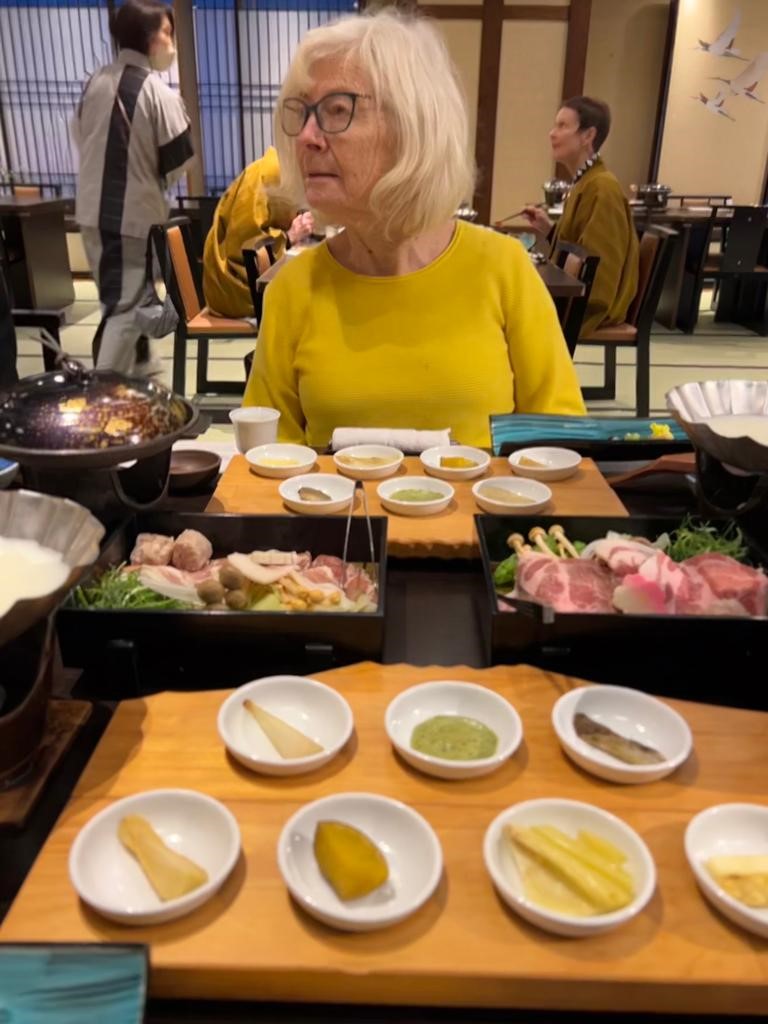
Staying at a ryokan includes dinner and breakfast as standard. Dinner is unusual. The presentation is impressive but also confusing and we need some instructions on how to proceed. We decide to start with Asahi beers since this is the one part of the process we understand well. We adopt the Japanese custom of pouring the beer for each other and conclude with a confident ‘Kampai!’.
The complete dinner is laid out before us. We have our own personal ‘nabes’ – the Japanese pot equivalent to the Swiss fondue dish – heated by gel fuel lit from underneath the pot but containing soy milk or stock rather than oil. A large container has our raw ingredients – appetising slices of wagyu beef, lengthy suspicious-looking fungi, weeds from the sea, a mix of vegetables for good measure and the inevitable tofu. The whole is ‘shabu-shabu’ – the cook-it yourself Japanese -style fondue. And our personal steamer is working away on the sticky rice.
The dinner starts innocently enough, but the slow shabu-shabu cooking process leaves idle time – time for the four of us to finally settle the argument of the day. It’s a trivial thing really but the discussion is soon fuelled by second rounds of Asahi beer, and then there’s no holding us back. The debate is about the ticket barrier at Nagoya railway station. Yes, that’s correct, the ticket barrier – a very divisive issue!
It’s a silly thing to argue over and we do get a bit loud and are clearly disturbing the other perfectly-behaved diners, working away quietly with their chopsticks, and dressed in the recommended ‘yukatas’. We, the rebels, are in jeans and sweaters. The Japanese culture is surprisingly forgiving of drink-inspired behaviour, provide that it doesn’t bother other people. But this is where we transgressed. Two of the guests – to become known as Mr & Mrs Glum – didn’t like it and later, in the bar, they tell us to quieten down. We decide to hit the town and find a friendly bar.
The ‘Izakaya’, a short walk down an alleyway is exactly that. A very Japanese bar, and very friendly. One of those places where there’s very little common language spoken but there’s a kind of international language of pleasantness. The bar specialises in hot sake, served by the jug, which we share with our new-found friends on both sides of the bar. By the time we leave, British – Japanese relations have been considerably enhanced.
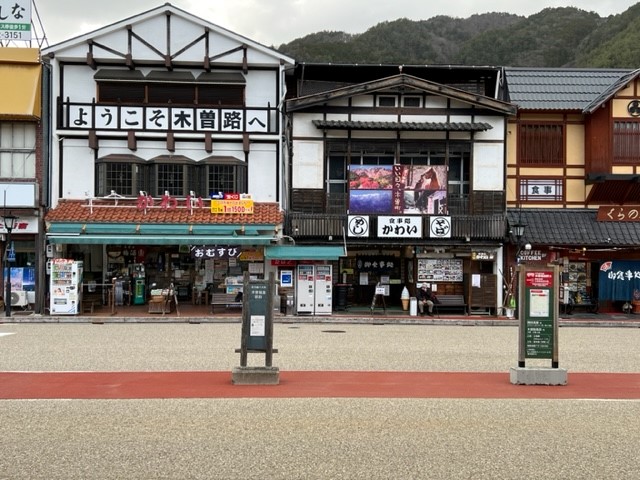
After a dinner and two breakfasts at the ryokan, we re-assess our enthusiasm for eating-in. The quality of the food is first class, but we are ready for a change from the very distinctive fare – the elaborate delicacies and morcels of sometimes unidentified food. It’s left us longing for a western menu – food we can recognise at a distance. So we decide to leave our fellow diners at the ryokan in peace while we try out the Japanese version of a French restaurant nearby. No French is spoken at this French restaurant, but the food, the ambience, and the French wine are all perfect. It’s another great evening.
Nagi introduces us to her Japanese friend Aich (not sure how I should be spelling it). Aich has worked for some time in Guildford, so knows western food well. He’s telling us about what he missed, Japan vs UK, and we are convinced he’s about to say how much he misses the ‘Full English’ breakfast in Surrey. But no, the opposite in fact – how happy he is to return to breakfast Japanese style. I guess we are all a product of our upbringing. The Japanese do have the advantage that they eat very healthily and it’s not so easy to load up the calories with chopsticks. The results – slim, healthy-looking people – are all around us. We do wonder how Sumo wrestlers pack on the weight. Do they gorge themselves on burgers and fries smothered in cheese flown in from Texas? It seems not – they eat the same food as the rest of the population, just five times more of it. And they skip breakfast.
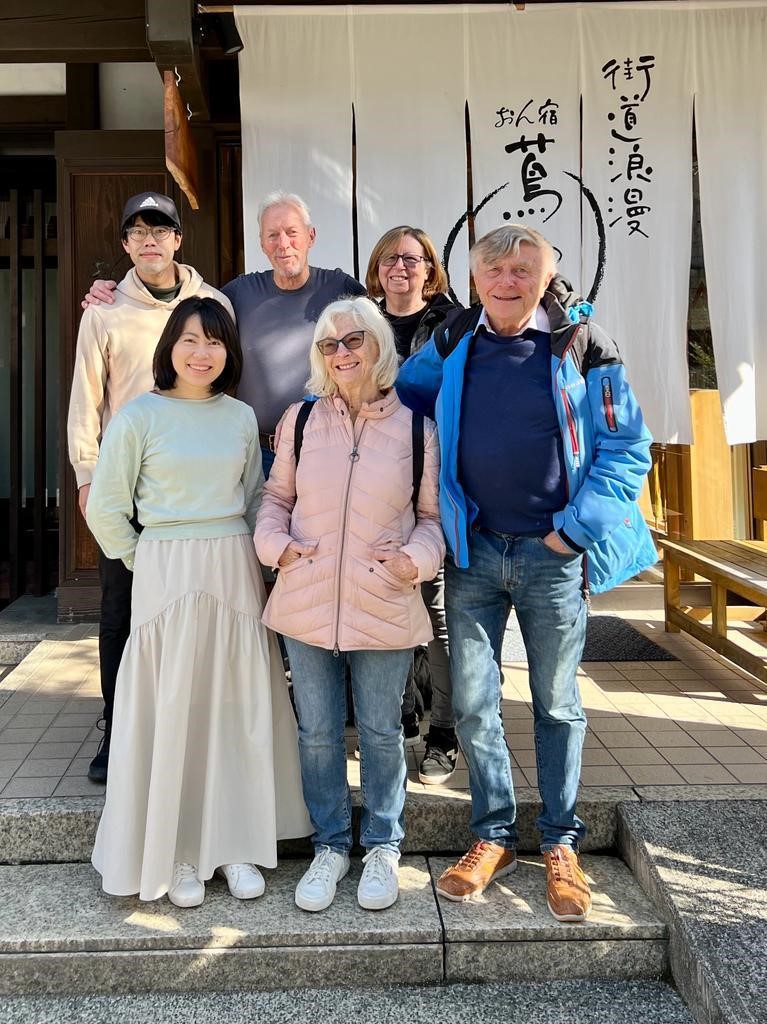
Our time in Kiso Fukashimo has been fascinating. We’ve trodden in the steps of Samurai on their way over the mountains; we’ve slept on futons in our twelve-tatami room; we’ve had the complete Ryokan dining experience; we’ve done the naked onsen thing and know where to bathe our feet in the street; we’ve experimented with hot sake and made new friends; we’ve tasted fine French food from a Japanese chef; and we’ve avoided dressing up in Japanese lounge gear.
….and so we move on.